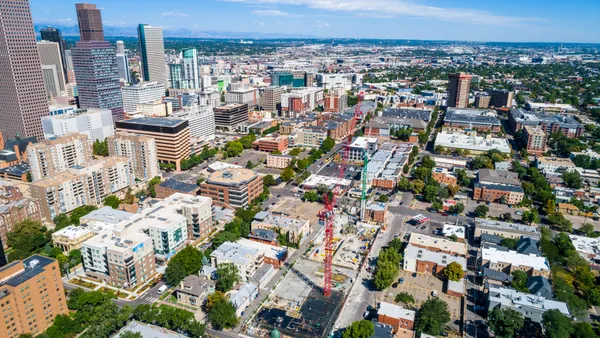Many hotel properties will need to undergo changes in order to meet local emissions reductions regulations — and soon.
In New York City, for instance, Local Law 97 requires hotels exceeding 25,000 square feet to cut 40% of their emissions by 2030, and reach an 80% reduction target by 2040. It’s all part of the city’s plan to achieve carbon neutrality by 2050 — the same year many hotel companies have targeted to reach their net zero goals.
“Fifty percent of the buildings that exist today will exist in 2050, which is when most organizations have their net zero ambitions targets,” Mike Kazmierczak, global vice president of digital energy at Schneider Electric, told Hotel Dive.
Outfitting properties with more efficient energy systems can help hotels reach their targets, but it can also be costly and disruptive. Owners and operators, Kazmierczak said, “need that return on investment to justify the business case to actually do these things.”
To help hoteliers determine that ROI, Kazmierczak’s team developed a Building Decarbonization Calculator aimed at helping building owners and operators calculate carbon emissions and energy use intensity, while identifying potential reduction measures. Kazmierczak sat down with Hotel Dive to discuss the new tool, the business case for hotel renovations and what factors hoteliers should consider when planning a retrofit.
A need for change
The need for more energy-efficient buildings goes beyond markets where regulations mandate emissions reduction.
Hilton, for instance, plans to reduce emissions for its managed hotel portfolio by 75% by 2030. Marriott International and Accor, meanwhile, both plan to go net zero by 2050.
Cognizant of these looming deadlines, Kazmierczak said his team at Schneider Electric began by asking: “How do we create the fastest path to net zero for our customers?”
Working in collaboration with JLL and C.scale, a decarbonization planning tool creator under San Francisco architectural firm EHDD, Kazmierczak hired a team of scientists to model the impacts of different building topologies, energy conservation measures, climate zones and other factors that affect properties. The resulting Decarbonization Calculator is trained on 500,000 such building performance models.
Schneider Electric plans to roll out the calculator for hotels “more widely” in 2025, Kazmierczak said.
How it works
Hotel owners and operators using Schneider Electric’s calculator can use it to look at individual properties or an entire portfolio, and the calculator can provide them with cost estimates for retrofits, ROI calculations and compliance modules for regulatory emissions laws, including Local Law 97.
To use it, hoteliers input information about their properties such as location, square footage and building age. They can then view how different kinds of updates could impact their properties — everything from light interventions and medium retrofits to deep renovations.
The calculator will then estimate cost and ROI, as well as flag local emissions regulations and compliance dates. The technology can also calculate the cost of doing nothing — such as the penalties a New York City hotel might face if it doesn’t comply with local emissions rules in time.
Under Local Law 97, penalties for late filings start at 50 cents per square foot per month, Facilities Dive reported.
“What we want to get across in this is that the things that are being done around sustainability are not only good for the environment, they’re also good for business performance,” Kazmierczak said. “It's helping you with your brand. It's helping increase the value of your property. It's helping you acquire new guests.”
Kazmierczak said he hopes his team’s work can bring more awareness to the power of retrofitting and lead “more people to take action.” Too often, he noted, hotel and other building managers don’t make changes, assuming city- and state-wide grid decarbonization initiatives will take care of emissions reductions for them. “We started to debunk those myths,” he said.
“If [hotels] take action now by retrofitting, the emissions impact is greater than starting in two or three years from now,” he said. “The sooner you take action with the technologies that exist, the bigger emissions impact you're going to have down the road.”





















